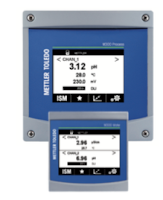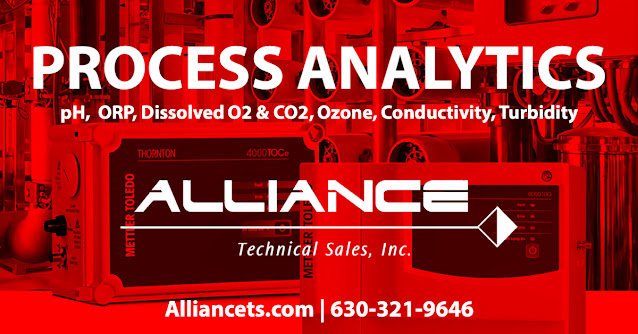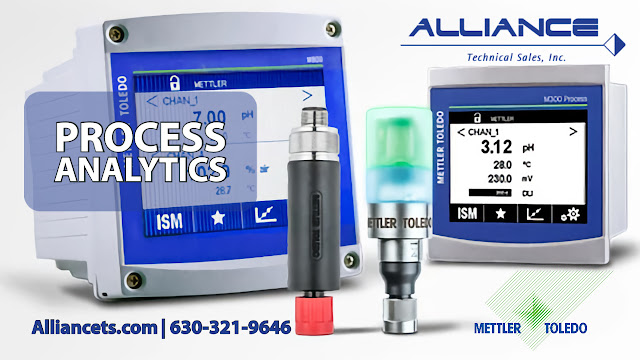An informative and educational resource specializing in process control instrumentation, analytical instruments, and related industrial equipment. Content includes technology basics, how-to's, new product developments, and application notes. Blog is courtesy of Alliance Technical Sales, a leading Manufacturers' Rep headquartered in Clarendon Hills, IL and serving customers in Illinois, Indiana, Iowa, Michigan and Wisconsin.
Process Analytics: Measuring and Controlling Vital Parameters in Industrial Applications
Process Analytics: Measuring pH, Dissolved Oxygen, and Conductivity
pH, dissolved oxygen, and conductivity are important parameters to measure in industrial processes because they can provide valuable information about the products' quality and safety. By measuring these parameters, industrial processes can ensure that they are operating within safe and optimal ranges, which can improve the quality and efficiency of the products.
pH
pH is a measure of the acidity or basicity of a solution, and it can significantly impact the behavior of chemicals in a process.
There are several ways to measure pH in industrial processes, including using a pH meter, pH test strips, and indicator solutions. A pH meter is a commonly used instrument that measures the pH of a solution by using a probe to measure the electrical potential difference between the solution and a reference electrode. pH test strips are also commonly used in industrial processes, as they are quick and easy to use and provide a general indication of the pH of a solution.
Dissolved Oxygen
Dissolved oxygen is vital because many industrial processes involve biological organisms that require oxygen to survive and function properly.
There are several ways to measure dissolved oxygen in industrial processes, but some of the most common methods include the following:
- Electrochemical sensors: These sensors use an electrode to measure dissolved oxygen concentration in a solution.
- Optical sensors: These sensors use light to measure the amount of dissolved oxygen in a solution.
- Membrane-based sensors: These sensors use a thin membrane to separate the sample being measured from the oxygen-sensitive material, allowing for accurate dissolved oxygen levels.
Conductivity
Conductivity is a measure of the ability of a solution to conduct electricity. It can provide information about the concentration of ions in the solution, which can be helpful in various applications.
Conductivity in industrial processes is typically measured using a conductivity meter. This device uses electrodes to pass an electrical current through a substance sample and measures the substance's resistance to the flow of electricity. The resistance converts into a conductivity reading, typically reported in units of siemens per meter (S/m).
It's worth noting that the most appropriate method for measuring dissolved oxygen, conductivity and pH in industrial processes will depend on the application's specific requirements. It's always a good idea to consult with an expert in the field to determine the best method for your particular needs.
METTLER TOLEDO provides analytical transmitters for a wide range of analytics, including pH/ORP, oxygen, dissolved carbon dioxide and conductivity or resistivity. These analytical transmitters are the component within a measurement system that communicates displayed measurements to a user or higher level control system. METTLER TOLEDO high-performance analytical transmitters offer compatibility with traditional analog sensors and digital sensors with METTLER TOLEDO's Intelligent Sensor Management (ISM).
Discuss your process analytics requirements with professional, skilled expert engineers. Alliance Technical Sales is available to assist in the application and specification of sensors, transmitters, and controllers for any industrial process. Call them at 630-321-9646 or visit their website at https://alliancets.com.
New 2020 Mettler Toledo Process Analytics Catalog
 Mettler Toledo Process Analytics, which includes the well-known Thornton and Ingold brands, has published their 2020 product catalog.
Mettler Toledo Process Analytics, which includes the well-known Thornton and Ingold brands, has published their 2020 product catalog.Ingold has a long track record of innovative high-quality solutions for demanding process analytics applications. Their products include systems for the measurement parameters of pH/ORP, dissolved oxygen (DO), dissolved CO2, conductivity and turbidity.
Thornton is the market leader in critical ultrapure and pure water analytics, where accuracy and reliability are essential. Their products include analytical instruments and sensors for the measurement of resistivity, conductivity, TOC, bioburden, pH, dissolved oxygen (DO), sodium, silica and ozone.
For more information, and to download the 2020 MT Process Analytics catalog, visit this Alliance Technical Sales webpage.
Alliance Technical Sales, Inc.
630-321-9646
https://alliancets.com
Validating Water Cycle pH Requirements Using Conductivity and Calculated pH
In thermal power plants, pH measurement and control in the water steam cycle are critical to minimizing corrosion. Cycle chemistry guidelines specifically target narrow pH ranges.
However, in high purity water and steam, there are not enough ions in the water to generate a pH response, causing the pH reading to be unstable. Fortunately, conductivity has a direct relationship with pH when the sample contains only pure water with the typical alkaline treatments, such as ammonia and amines. In fact, cycle chemistry in many plants relies primarily on the related specific conductivity values. However, correction for minor contaminants by measuring the cation conductivity of the sample is needed to provide accurate results. The specific and the cation conductivity values are used in an industry accepted calculation that provides the highest accurate conversion to pH. Under normal operating conditions, this calculation provides more accurate and reliable results than pH electrodes can provide, for two reasons:
- Conductivity is linear, with concentration which provides much higher resolution than pH sensors all of which give nonlinear response to concentration.
- Conductivity sensors can be directly calibrated with minimal introduction of error.
This makes calculated pH based on conductivity significantly more accurate. However, with major contamination, such as when a condensate exchange polisher's resin is exhausted, and an acid leak occurs, the pH would drop below 7, which is outside the ideal range for using calculated pH and would generate errors. Thus, to avoid contamination, it is recommended that both traditional pH measurement, and calculated pH based on conductivity, be used for optimal pH control.
METTLER TOLEDO Thornton's M800 multi-parameter transmitter can provide traditional pH measurement, calculated pH, as well as specific and cation conductivity to ensure accurate and reliable pH control. The M800 even has a built-in alarm to alert you if the pH measurement deviates from the calculated pH measurement for extra security and peace of mind.
For more infomration about METTLER TOLEDO Process Analytics products, contact Alliance Technical Sales by calling 630-321-9646 or by visiting https://alliancets.com.
UniCond Sensor Measures Conductivity of Water with Varying Purity Levels & Temperatures
| UniCond Sensor |
1) Unmatched Accuracy - a self-contained measuring circuit which produces a robust output digital signal that is reliable over very long cable and certified factory calibration and temperature compensation with ASTM traceability stored in the sensor's internal memory to ensure highest installed accuracy out of the box.
2) Widest Rangeability - A single 2-electrode UniCond sensor can measure from ultrapure water all the way up to sea water with high accuracy. This significantly simplifies the specification, installation and spare parts inventory for water treatment systems. 4-electrode UniCond sensors cover the higher conductivity ranges of acid and base ion exchange regeneration chemicals.
3) Maintenance-free Performance - Mettler Toledo Thornton conductivity sensors for pure water provide high accuracy measurements with widely spaced electrodes that do not trap ion exchange resin particles, corrosion particles or bubbles, and yield more reliable, maintenance-free operation than with other sensors.
https://alliancets.com
630-321-9646
Retractable Sensor Housing for Analytical Sensors
 |
| The retractable sensor housings are available in several configurations |
Mettler Toledo, under their Ingold brand of process analytic products, provides a solution in the form of a retractable sensor housing. Models accommodate sensors for pH, redox, conductivity, and dissolved oxygen. The housings are designed to enable safe retraction of the sensor from the process, with in place sensor cleaning or further maintenance operations made simple with the process remaining in operation.
The document below provides additional detail. Share your process analytical challenges with an application expert, combining your own process experience and knowledge with their product application expertise to develop effective solutions.
Alliance Adds Thornton to Process Analytical Instrument Offering
Share your fluid process analytical challenges with product application experts, combining your process knowledge and experience with their product application expertise to develop effective solutions.
Paths for Optimizing Chemical Industry Processes
 |
| Ingold brand InPro pH probes Courtesy Mettler Toledo |
There is a robust section of the measurement and control equipment industry devoted to analytical measurements for chemical processes. Mettler Toledo, with their Ingold brand of analytical instrumentation, has been a key player in the process analytical field for many years. Through continuous research and development, the company has innovated products that provide greater performance and operational benefits to their industrial process control customers.
The piece included below provides a useful overview of the company's analytical and measurement capabilities, with an emphasis on how the products are employed in various industries. Modern technology is incorporated to improve product life cycle performance and reduce maintenance burden.
See for yourself with a browse through the document included below. More information is available on products and applications from a specialist, with whom you should share your analytical process challenges. The most effective solutions will come from collaboration between process operators and analytical equipment specialists.
New Generation of Mettler Toledo M300 pH/ORP, Dissolved Oxygen, Conductivity, & Ozone Transmitters
 |
| M300 Process Transmitter |
The multi-parameter M300Process transmitter line for pH/ORP, dissolved oxygen, conductivity and ozone measurements offers exceptional measurement performance as well as excellent user ergonomics.
The high contrast black and white touchscreen together with the harmonized menu structure for all parameters, facilitates navigation and ensures easy and user friendly operation.
On-line diagnostics information allows you to schedule sensor maintenance or replacement. The clearly visible diagnostic information lets you know when it’s time to do maintenance or calibration of sensors equipped with Intelligent Sensor Management (ISM) technology.
The integrated USB interface allows you to use it for data logging or to store the configuration on a USB stick.
Second generation M300 transmitters are direct replacements to first generation products.
For more information, contact:
Alliance Technical Sales
312 Park Avenue Unit 145
Clarendon Hills, 60514-0145
Phone: 630-321-9646
Fax: 630-321-9647
www.alliancets.com


